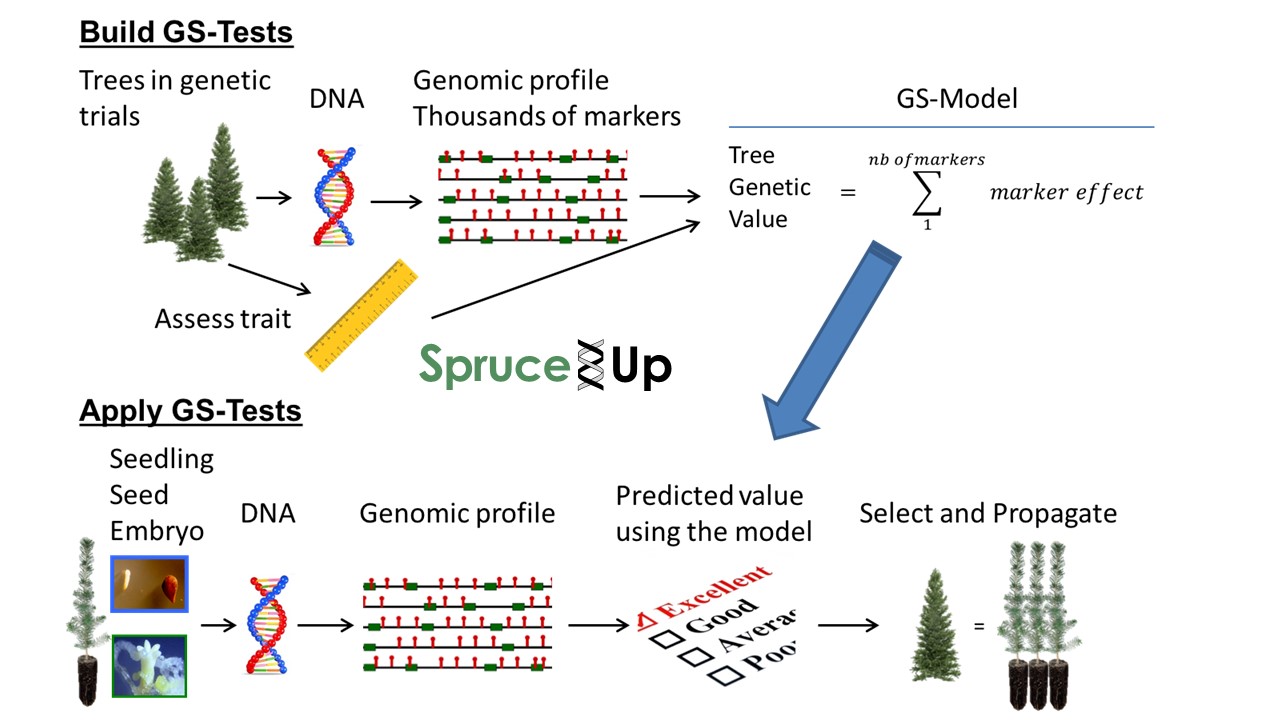We will develop genomic selection systems to accelerate the development of improved white spruce stock for new wood quality and productivity traits with our partner End-Users Canadian Wood Fibre Centre (CWFC) and Ministère des Forêts, de la Faune et des Parcs du Québec (MFFPQ). CWFC and Forest Products Innovations of Canada (FPI) are also involved in developing and implementing innovative phenotyping tools such as the LIDAR technology and, through their national mandates, facilitate translation across the Canadian forest sector.
Genomic selection (GS) is a diagnostic tool/method allowing the rapid prediction of the genetic value of trees used in breeding programs at a very young age and for a large number of candidate individuals in screening. The procedure is based on multi-locus genotypic information (genomic profiles). In conventional breeding, spruce trees are evaluated in the field for up to 30 years. In contrast, with GS, trees are evaluated at the seed or seedling stage by their genomic profiles, thus greatly accelerating selection.

Our proof-of-concept work in the SMarTForests Project (www.smartforests.ca) showed that GS could be developed and applied to spruce advanced-breeding populations with high accuracy and large acceleration of genetic gains for traits such as growth and wood density. We showed that genomic selection can reduce the time needed for completion of a spruce breeding cycle by two thirds, which is a considerable advantage for breeding of slow-growing boreal conifers and for traits that usually require decades of expensive field evaluation.
While generating large economic benefits, early GS also provides increased flexibility for breeders to respond to uncertain futures, such as accelerated selection and production of faster-growing and high quality spruce stocks, thus reducing risks. This is critical for industry competitiveness in rapidly changing markets and for forest practitioners working in a context of rapid environmental changes.
Stem biomass in particular is a useful proxy of carbon fixation, which is gaining interest in the context of emerging carbon markets and capping of carbon emissions. These factors are genetically variable, which makes it possible through selection to increase profits at both the harvesting and sawmilling stages. Together with our end-user partners, we will provide the GS tools and implementation of the knowledge to provincial spruce breeding programs.
Objectives
- Develop and apply rapid phenotyping methods for dendrometrical assessment of spruce trees and plantations, and estimate genetic gains in white spruce for traits such as wood homogeneity and stiffness, crown shape and branching pattern, and biomass and carbon fixation to meet national goals aimed at improving Canadian forest industry competitiveness.
- Develop and implement at the operational scale, with our partner End-Users CWFC and MFFPQ, cost-effective genomic selection systems for wood quality and productivity traits in white spruce to shorten breeding cycles, reduce costs and provide more flexibility to spruce breeders; as well, integrating with genomic selection systems for traits related to resilience to biotic and abiotic stress factors, in linkage with Activities 3 & 4.